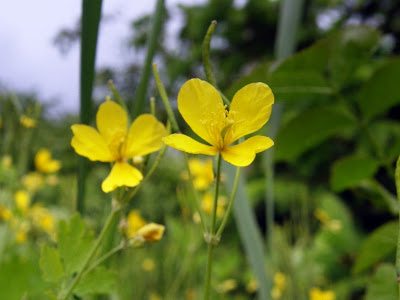
One of the 'weeds' that grows freely in the wilder parts of my back garden is the Greater celandine (Chelidonium majus). I was first introduced to its homeopathic values by my godfather, an acknowledged herb doctor ( among other herbs, algae and his 'secret' ingridients, he used it to cure his seriously ill mother from an inoperable breast cancer, and even though at the age of 84, his mum showed up in hospital months later and both her tumor and metastasis were gone, and she lived to be 101 years old). In old homeopathy books one could often run into other names apart from Celandine, such as Mary's plant, Gift of God, Snake's milk and so on... All in all, in those times, it was renowned for its many healing values. Today many people look at it as nothing more than an annoying and dangerously invasive weed. The invasive part, well, that's true to some extent, but nothing to fuss about. And it's nice to look at anyway. I always thought it was a lovely wildflower ;-)
The invasive part, well, that's true to some extent, but nothing to fuss about. And it's nice to look at anyway. I always thought it was a lovely wildflower ;-)
The widespread indifference towards this 'annoying weed' might have its roots somewhere in the beginning of medical industry when all the highly curative plants were discarded in order to make people rely on chemicals rather than homeopathy. Being cursed and ditched away, some 'scientists' even tagged it as highly toxic.
Crude extracts of this plant are known to have anti-viral, anti-inflammatory, anti-tumor and anti-microbial properties and has been regularly used against various liver disorders including cancer in humans. It contains an orange-colored juice that has been used medicinally for thousands of years. It has been applied topically for eye and skin problems, and taken internally for bronchitis, jaundice, indigestion, cancer, and whooping cough. My friends often come for a fresh supply when in need to treat their verrucae - a tincture made from celandine is said to be antiviral and damages wart cells.

DETAILS: Clump-forming perennial, Zones 3-9. Europe, pre-1600. Buttercup like yellow flowers. Long blooming. Height 30". Self-seeding (actually the celandine seeds are dispersed by ants; that being facilitated by an elaiosome on the seed which attracts the ants so that they move it). Full sun to light shade and a fertile loamy soil.
Monday, 5 May 2008
Homeopathy: Greater celandine
Scribbled by
Viooltje
@
20:23
Subscribe to:
Post Comments (Atom)













 Top Gardening Sites
Top Gardening Sites


2 komentari:
This is great post - thank you. Very interesting information :)
Yes - yes this is very interesting.
I have never seen it growing in anyone's garden and, in my part of Dorset (Southern England, half way along the coast) it is mostly the lesser celandine we see.
But - nevertheless - fascinating.
Esther
Post a Comment